C74MSH Essay: Genetic and Diagnostic Screening - Molecular Genetics
VerifiedAdded on 2022/09/27
|11
|2813
|22
Essay
AI Summary
This essay provides a comprehensive overview of genetic and diagnostic screening, encompassing its historical evolution, current applications, and the controversies surrounding it. It begins by defining screening and its purpose in early disease detection, emphasizing the advancements in extending lifespans and improving healthcare. The essay explores various screening methods, including diagnostic and genetic testing, highlighting examples like newborn bloodspot screening for disorders such as Phenylketonuria and the Pap test for cancer. It discusses the rise of molecular diagnostics and new technologies like Whole Exome sequencing and Array Comparative Genome Hybridisation (CGH). The essay also addresses ethical considerations, such as the potential for discrimination and the need for regulatory oversight, while also exploring controversial issues like artificial insemination and assisted reproduction techniques. In conclusion, the essay underscores the importance of ethical considerations in the application of genetic and diagnostic screening, while recognizing its potential in early disease identification and treatment.

Running head: ESSAY 1
ESSAY 1
Name of the Student:
Name of the University:
Author’s Note:
ESSAY 1
Name of the Student:
Name of the University:
Author’s Note:
Paraphrase This Document
Need a fresh take? Get an instant paraphrase of this document with our AI Paraphraser
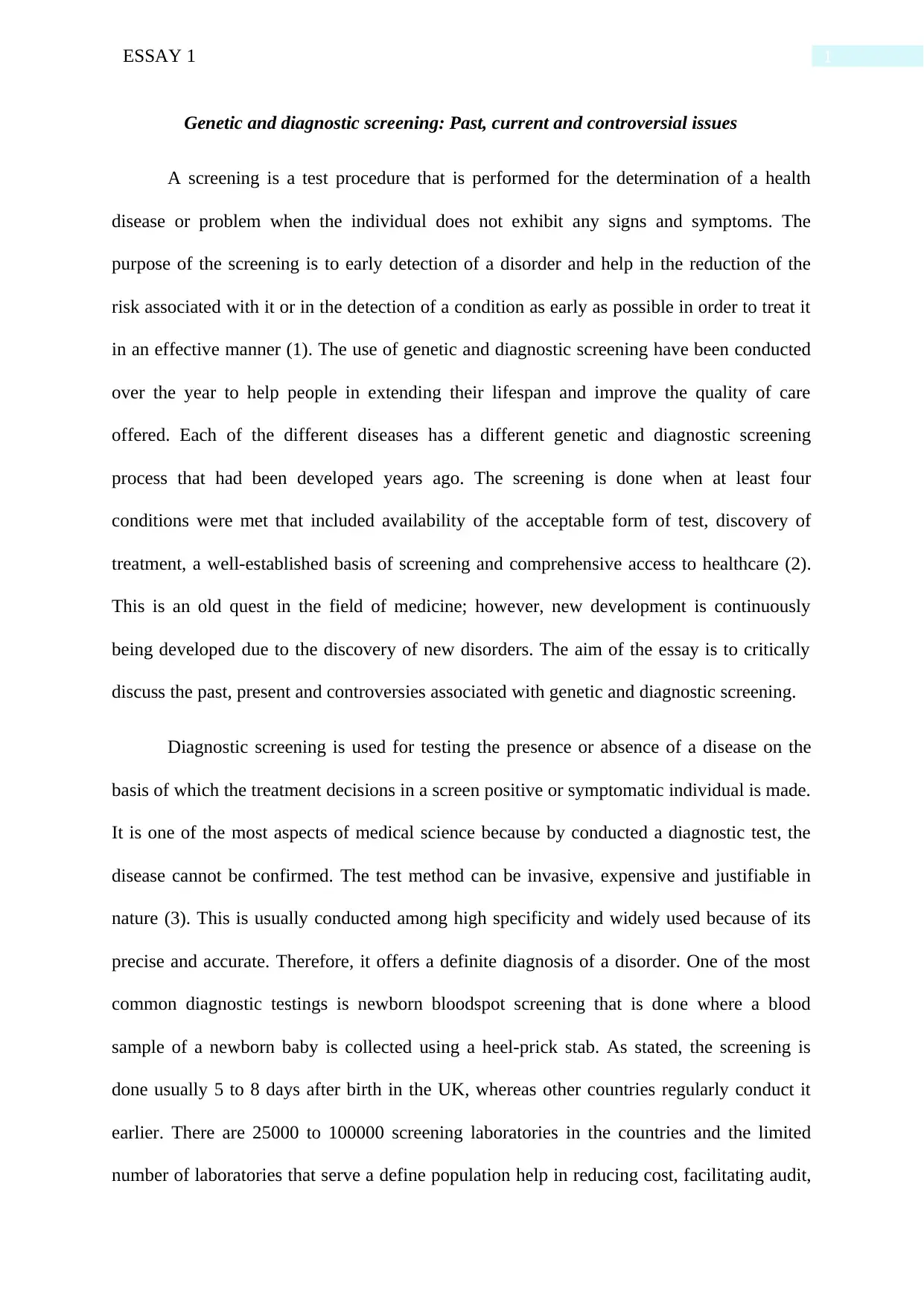
1ESSAY 1
Genetic and diagnostic screening: Past, current and controversial issues
A screening is a test procedure that is performed for the determination of a health
disease or problem when the individual does not exhibit any signs and symptoms. The
purpose of the screening is to early detection of a disorder and help in the reduction of the
risk associated with it or in the detection of a condition as early as possible in order to treat it
in an effective manner (1). The use of genetic and diagnostic screening have been conducted
over the year to help people in extending their lifespan and improve the quality of care
offered. Each of the different diseases has a different genetic and diagnostic screening
process that had been developed years ago. The screening is done when at least four
conditions were met that included availability of the acceptable form of test, discovery of
treatment, a well-established basis of screening and comprehensive access to healthcare (2).
This is an old quest in the field of medicine; however, new development is continuously
being developed due to the discovery of new disorders. The aim of the essay is to critically
discuss the past, present and controversies associated with genetic and diagnostic screening.
Diagnostic screening is used for testing the presence or absence of a disease on the
basis of which the treatment decisions in a screen positive or symptomatic individual is made.
It is one of the most aspects of medical science because by conducted a diagnostic test, the
disease cannot be confirmed. The test method can be invasive, expensive and justifiable in
nature (3). This is usually conducted among high specificity and widely used because of its
precise and accurate. Therefore, it offers a definite diagnosis of a disorder. One of the most
common diagnostic testings is newborn bloodspot screening that is done where a blood
sample of a newborn baby is collected using a heel-prick stab. As stated, the screening is
done usually 5 to 8 days after birth in the UK, whereas other countries regularly conduct it
earlier. There are 25000 to 100000 screening laboratories in the countries and the limited
number of laboratories that serve a define population help in reducing cost, facilitating audit,
Genetic and diagnostic screening: Past, current and controversial issues
A screening is a test procedure that is performed for the determination of a health
disease or problem when the individual does not exhibit any signs and symptoms. The
purpose of the screening is to early detection of a disorder and help in the reduction of the
risk associated with it or in the detection of a condition as early as possible in order to treat it
in an effective manner (1). The use of genetic and diagnostic screening have been conducted
over the year to help people in extending their lifespan and improve the quality of care
offered. Each of the different diseases has a different genetic and diagnostic screening
process that had been developed years ago. The screening is done when at least four
conditions were met that included availability of the acceptable form of test, discovery of
treatment, a well-established basis of screening and comprehensive access to healthcare (2).
This is an old quest in the field of medicine; however, new development is continuously
being developed due to the discovery of new disorders. The aim of the essay is to critically
discuss the past, present and controversies associated with genetic and diagnostic screening.
Diagnostic screening is used for testing the presence or absence of a disease on the
basis of which the treatment decisions in a screen positive or symptomatic individual is made.
It is one of the most aspects of medical science because by conducted a diagnostic test, the
disease cannot be confirmed. The test method can be invasive, expensive and justifiable in
nature (3). This is usually conducted among high specificity and widely used because of its
precise and accurate. Therefore, it offers a definite diagnosis of a disorder. One of the most
common diagnostic testings is newborn bloodspot screening that is done where a blood
sample of a newborn baby is collected using a heel-prick stab. As stated, the screening is
done usually 5 to 8 days after birth in the UK, whereas other countries regularly conduct it
earlier. There are 25000 to 100000 screening laboratories in the countries and the limited
number of laboratories that serve a define population help in reducing cost, facilitating audit,
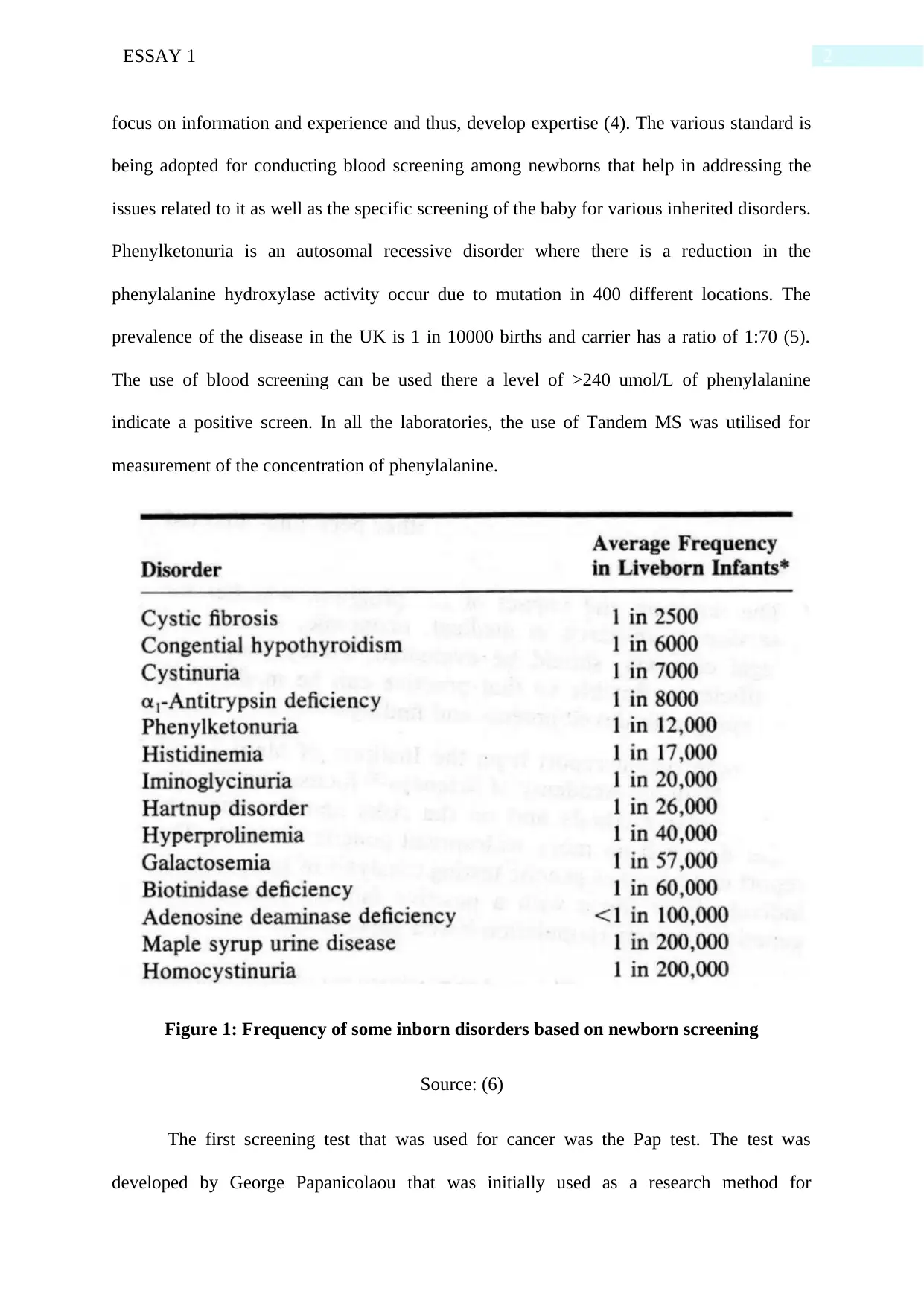
2ESSAY 1
focus on information and experience and thus, develop expertise (4). The various standard is
being adopted for conducting blood screening among newborns that help in addressing the
issues related to it as well as the specific screening of the baby for various inherited disorders.
Phenylketonuria is an autosomal recessive disorder where there is a reduction in the
phenylalanine hydroxylase activity occur due to mutation in 400 different locations. The
prevalence of the disease in the UK is 1 in 10000 births and carrier has a ratio of 1:70 (5).
The use of blood screening can be used there a level of >240 umol/L of phenylalanine
indicate a positive screen. In all the laboratories, the use of Tandem MS was utilised for
measurement of the concentration of phenylalanine.
Figure 1: Frequency of some inborn disorders based on newborn screening
Source: (6)
The first screening test that was used for cancer was the Pap test. The test was
developed by George Papanicolaou that was initially used as a research method for
focus on information and experience and thus, develop expertise (4). The various standard is
being adopted for conducting blood screening among newborns that help in addressing the
issues related to it as well as the specific screening of the baby for various inherited disorders.
Phenylketonuria is an autosomal recessive disorder where there is a reduction in the
phenylalanine hydroxylase activity occur due to mutation in 400 different locations. The
prevalence of the disease in the UK is 1 in 10000 births and carrier has a ratio of 1:70 (5).
The use of blood screening can be used there a level of >240 umol/L of phenylalanine
indicate a positive screen. In all the laboratories, the use of Tandem MS was utilised for
measurement of the concentration of phenylalanine.
Figure 1: Frequency of some inborn disorders based on newborn screening
Source: (6)
The first screening test that was used for cancer was the Pap test. The test was
developed by George Papanicolaou that was initially used as a research method for
⊘ This is a preview!⊘
Do you want full access?
Subscribe today to unlock all pages.

Trusted by 1+ million students worldwide

3ESSAY 1
understanding the menstrual cycle. After its discovery, Papanicolaou recognised that it has
potential in assessing cervical cancer identification and after many years, it was being
accepted. After the wide-scale recognition of diagnostic testing in the world, it has been used
by healthcare professionals. There is a 4% annual growth foot general diagnostic and 15% in
the molecular diagnosis in the market. Furthermore, it was found that the market of molecular
diagnostic had reached $4.8 billion in 2011 and had been expected to reach $9.3 billion by
2020 (7).
Figure 2: Market of molecular diagnostic
Source: (8)
With the growth in the market, new and developed screening methods were
introduced. This includes Whole Exome sequencing that was found to be a definite diagnosis
process in a child who had intractable inflammatory bowel disease. This was an X-linked
inhibitor of apoptosis deficiency that was treated with an allogeneic hematopoietic progenitor
cell transplant. After forty-two days of the transplant, the child was able to eat and drink and
thus, there was no recurrence of gastrointestinal disease. Miniaturised sensing systems,
MALDI-TOF that helped in the identification of pathogens in the clinical laboratory and
understanding the menstrual cycle. After its discovery, Papanicolaou recognised that it has
potential in assessing cervical cancer identification and after many years, it was being
accepted. After the wide-scale recognition of diagnostic testing in the world, it has been used
by healthcare professionals. There is a 4% annual growth foot general diagnostic and 15% in
the molecular diagnosis in the market. Furthermore, it was found that the market of molecular
diagnostic had reached $4.8 billion in 2011 and had been expected to reach $9.3 billion by
2020 (7).
Figure 2: Market of molecular diagnostic
Source: (8)
With the growth in the market, new and developed screening methods were
introduced. This includes Whole Exome sequencing that was found to be a definite diagnosis
process in a child who had intractable inflammatory bowel disease. This was an X-linked
inhibitor of apoptosis deficiency that was treated with an allogeneic hematopoietic progenitor
cell transplant. After forty-two days of the transplant, the child was able to eat and drink and
thus, there was no recurrence of gastrointestinal disease. Miniaturised sensing systems,
MALDI-TOF that helped in the identification of pathogens in the clinical laboratory and
Paraphrase This Document
Need a fresh take? Get an instant paraphrase of this document with our AI Paraphraser
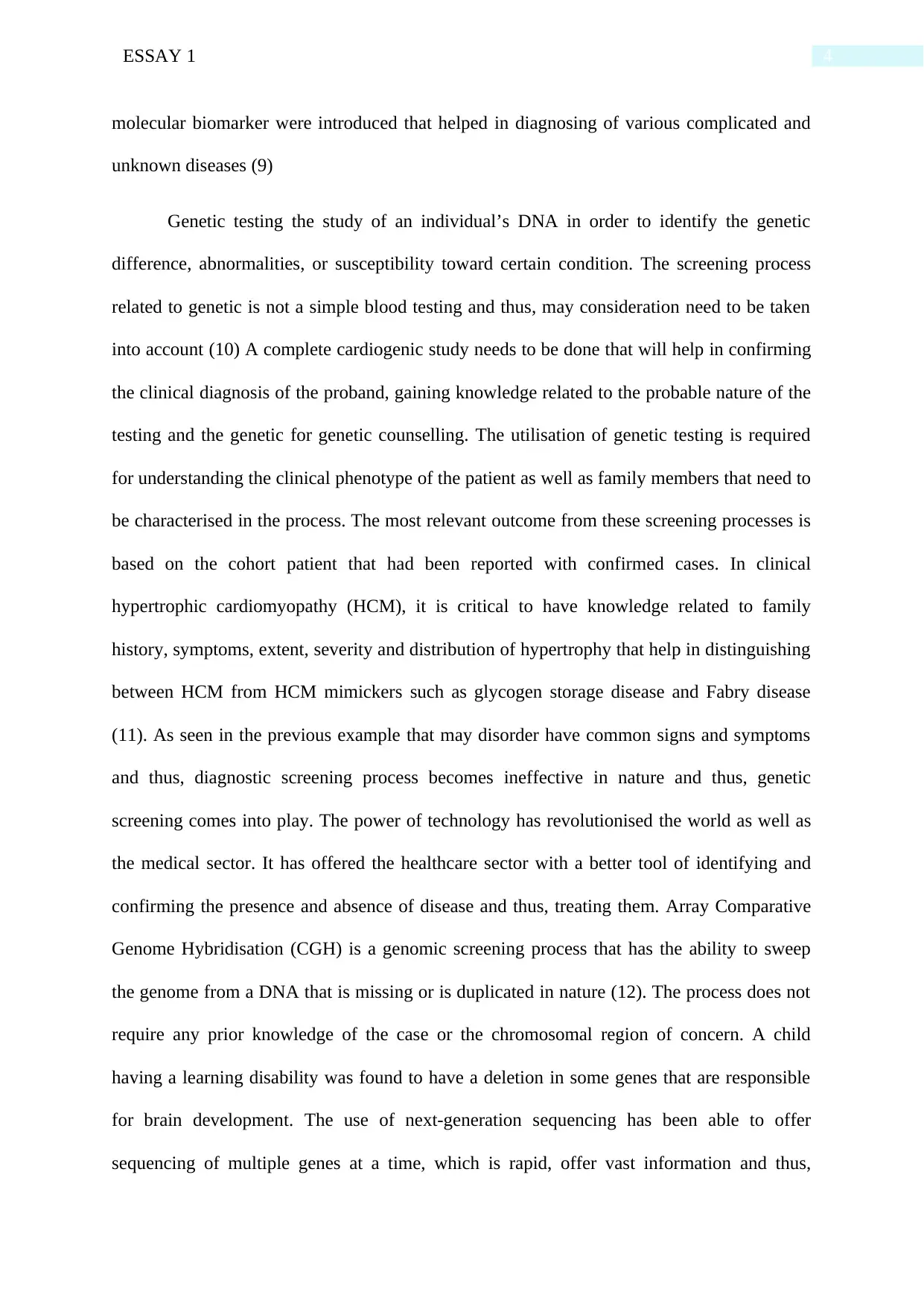
4ESSAY 1
molecular biomarker were introduced that helped in diagnosing of various complicated and
unknown diseases (9)
Genetic testing the study of an individual’s DNA in order to identify the genetic
difference, abnormalities, or susceptibility toward certain condition. The screening process
related to genetic is not a simple blood testing and thus, may consideration need to be taken
into account (10) A complete cardiogenic study needs to be done that will help in confirming
the clinical diagnosis of the proband, gaining knowledge related to the probable nature of the
testing and the genetic for genetic counselling. The utilisation of genetic testing is required
for understanding the clinical phenotype of the patient as well as family members that need to
be characterised in the process. The most relevant outcome from these screening processes is
based on the cohort patient that had been reported with confirmed cases. In clinical
hypertrophic cardiomyopathy (HCM), it is critical to have knowledge related to family
history, symptoms, extent, severity and distribution of hypertrophy that help in distinguishing
between HCM from HCM mimickers such as glycogen storage disease and Fabry disease
(11). As seen in the previous example that may disorder have common signs and symptoms
and thus, diagnostic screening process becomes ineffective in nature and thus, genetic
screening comes into play. The power of technology has revolutionised the world as well as
the medical sector. It has offered the healthcare sector with a better tool of identifying and
confirming the presence and absence of disease and thus, treating them. Array Comparative
Genome Hybridisation (CGH) is a genomic screening process that has the ability to sweep
the genome from a DNA that is missing or is duplicated in nature (12). The process does not
require any prior knowledge of the case or the chromosomal region of concern. A child
having a learning disability was found to have a deletion in some genes that are responsible
for brain development. The use of next-generation sequencing has been able to offer
sequencing of multiple genes at a time, which is rapid, offer vast information and thus,
molecular biomarker were introduced that helped in diagnosing of various complicated and
unknown diseases (9)
Genetic testing the study of an individual’s DNA in order to identify the genetic
difference, abnormalities, or susceptibility toward certain condition. The screening process
related to genetic is not a simple blood testing and thus, may consideration need to be taken
into account (10) A complete cardiogenic study needs to be done that will help in confirming
the clinical diagnosis of the proband, gaining knowledge related to the probable nature of the
testing and the genetic for genetic counselling. The utilisation of genetic testing is required
for understanding the clinical phenotype of the patient as well as family members that need to
be characterised in the process. The most relevant outcome from these screening processes is
based on the cohort patient that had been reported with confirmed cases. In clinical
hypertrophic cardiomyopathy (HCM), it is critical to have knowledge related to family
history, symptoms, extent, severity and distribution of hypertrophy that help in distinguishing
between HCM from HCM mimickers such as glycogen storage disease and Fabry disease
(11). As seen in the previous example that may disorder have common signs and symptoms
and thus, diagnostic screening process becomes ineffective in nature and thus, genetic
screening comes into play. The power of technology has revolutionised the world as well as
the medical sector. It has offered the healthcare sector with a better tool of identifying and
confirming the presence and absence of disease and thus, treating them. Array Comparative
Genome Hybridisation (CGH) is a genomic screening process that has the ability to sweep
the genome from a DNA that is missing or is duplicated in nature (12). The process does not
require any prior knowledge of the case or the chromosomal region of concern. A child
having a learning disability was found to have a deletion in some genes that are responsible
for brain development. The use of next-generation sequencing has been able to offer
sequencing of multiple genes at a time, which is rapid, offer vast information and thus,

5ESSAY 1
possess greater efficiency. Furthermore, it has an improved diagnosed rate and reduction in
the time of diagnosis. One of the most common causes of death in the world in modern time
is cancer and thus, clinical genetics have been employed in the identification and detection of
the disease. As it is a well-known fact that cancer can be treated if detected at an early stage,
thus, the emphasis of early detection using genetic as well as diagnostic screening has been
done. It was estimated that over 50% of the referrals related to clinical genetics is related to
cancer. In the majority of the cases, cancer is sporadic in nature as a result of which, the age
of diagnosis of it is found in the later stages of life. There are 5-10% of the hereditary cancers
and thus, the signs and symptoms have an onset at an earlier age (13).
Location of Cancer Disease
Breast Breast Cancer, Fraumeni syndrome,
Cowden syndrome
Bowel Polyposis genes and Lynch syndrome
Table 1: Common cancers
Even though the molecular diagnostic screening techniques are being widely sued in
the field of healthcare; however, there certain factors that need to be evaluated. The factors
include cost, simplicity in operation, the population of screening, assessing of the cost of
treating if not detected early, the cots benefit of detecting the disease at an early stage,
qualitative benefit, and estimation of the Disability-adjustment life years (DALY). Thus, an
audit is conducted by the medical board who allow the development of a new screening
method. There are ethical considerations that need to be taken into consideration while
applying the screening on the individual. There is an overlap between the categorisation and
the disease itself in many cases and it has been found that early detection of the disease in
many cases such as diabetes during pregnancy was reported to have worse pregnancy
possess greater efficiency. Furthermore, it has an improved diagnosed rate and reduction in
the time of diagnosis. One of the most common causes of death in the world in modern time
is cancer and thus, clinical genetics have been employed in the identification and detection of
the disease. As it is a well-known fact that cancer can be treated if detected at an early stage,
thus, the emphasis of early detection using genetic as well as diagnostic screening has been
done. It was estimated that over 50% of the referrals related to clinical genetics is related to
cancer. In the majority of the cases, cancer is sporadic in nature as a result of which, the age
of diagnosis of it is found in the later stages of life. There are 5-10% of the hereditary cancers
and thus, the signs and symptoms have an onset at an earlier age (13).
Location of Cancer Disease
Breast Breast Cancer, Fraumeni syndrome,
Cowden syndrome
Bowel Polyposis genes and Lynch syndrome
Table 1: Common cancers
Even though the molecular diagnostic screening techniques are being widely sued in
the field of healthcare; however, there certain factors that need to be evaluated. The factors
include cost, simplicity in operation, the population of screening, assessing of the cost of
treating if not detected early, the cots benefit of detecting the disease at an early stage,
qualitative benefit, and estimation of the Disability-adjustment life years (DALY). Thus, an
audit is conducted by the medical board who allow the development of a new screening
method. There are ethical considerations that need to be taken into consideration while
applying the screening on the individual. There is an overlap between the categorisation and
the disease itself in many cases and it has been found that early detection of the disease in
many cases such as diabetes during pregnancy was reported to have worse pregnancy
⊘ This is a preview!⊘
Do you want full access?
Subscribe today to unlock all pages.

Trusted by 1+ million students worldwide

6ESSAY 1
outcome as compared to those that had not been screening (14). This poses an ethical
question to the system. The heterogeneous early phenotype is stated to have a continuous risk
of the disease than those that had not being detected or detected at later stages. In addition,
various pathways, hormonal activities and other factors are associated with early detection
that plays an important role in the heterogeneity of the early detection process. It can be seen
that there is much importance being presented to the ethical implications of genomic data
with respect to research; however, its implication in the clinical settings is still debatable in
nature. The aspects that pose a threat, in this case, are these are secondary findings, the role
of genetic counsellor and educators are not being addressed in an appropriate manner and it
may breach the privacy aspect of individual and in some case, it may be a cause of
discrimination. In order to mitigate the ethical issue, regulatory bodies such as the Food and
Drug Administration (FDA) and the Human Genetic Commission in the UK monitor the
issues and support in policymaking (15). The controversial issues that are potential
contention are artificial insemination, patent invalidity; assisted reproduction techniques and
others that are still under investigation. The ethical aspects restrict usage in many cases or
even responsible for delaying the identification of a genetic disorder that may lead to the
serious implication of the quality of life of the individual.
From the essay, it can be concluded that genetic and diagnostic screening is one of a
kind process that is used for early identification of disease. The individual that did not have
any symptoms may have the disease for a long time such as some form of cancer and when
the diagnosis is made, it becomes too late to treat. Therefore, the genetic and diagnostic
screening processes are being introduced that help in mitigating the issue. It has long been
introduced ad with the help of technological development, the advancement in these
techniques is increasing day-by-day. Various new and innovation screening processes are
made available that are cost-effective and time-friendly in nature that allows in early and
outcome as compared to those that had not been screening (14). This poses an ethical
question to the system. The heterogeneous early phenotype is stated to have a continuous risk
of the disease than those that had not being detected or detected at later stages. In addition,
various pathways, hormonal activities and other factors are associated with early detection
that plays an important role in the heterogeneity of the early detection process. It can be seen
that there is much importance being presented to the ethical implications of genomic data
with respect to research; however, its implication in the clinical settings is still debatable in
nature. The aspects that pose a threat, in this case, are these are secondary findings, the role
of genetic counsellor and educators are not being addressed in an appropriate manner and it
may breach the privacy aspect of individual and in some case, it may be a cause of
discrimination. In order to mitigate the ethical issue, regulatory bodies such as the Food and
Drug Administration (FDA) and the Human Genetic Commission in the UK monitor the
issues and support in policymaking (15). The controversial issues that are potential
contention are artificial insemination, patent invalidity; assisted reproduction techniques and
others that are still under investigation. The ethical aspects restrict usage in many cases or
even responsible for delaying the identification of a genetic disorder that may lead to the
serious implication of the quality of life of the individual.
From the essay, it can be concluded that genetic and diagnostic screening is one of a
kind process that is used for early identification of disease. The individual that did not have
any symptoms may have the disease for a long time such as some form of cancer and when
the diagnosis is made, it becomes too late to treat. Therefore, the genetic and diagnostic
screening processes are being introduced that help in mitigating the issue. It has long been
introduced ad with the help of technological development, the advancement in these
techniques is increasing day-by-day. Various new and innovation screening processes are
made available that are cost-effective and time-friendly in nature that allows in early and
Paraphrase This Document
Need a fresh take? Get an instant paraphrase of this document with our AI Paraphraser

7ESSAY 1
quick detection. Thus, treatment can be initiated as soon as possible. However, there are a
number of the ethical issue because of which it has been associated with various
controversies. Thus, it is important to take into account these ethical considerations prior to
its application.
quick detection. Thus, treatment can be initiated as soon as possible. However, there are a
number of the ethical issue because of which it has been associated with various
controversies. Thus, it is important to take into account these ethical considerations prior to
its application.

8ESSAY 1
References
1. Group TN, Gregg AR, Gross SJ, Best RG, Monaghan KG, Bajaj K, Skotko BG, Thompson
BH, Watson MS. ACMG statement on noninvasive prenatal screening for fetal aneuploidy.
Genetics in Medicine. 2013 May;15(5):395.
2. Lee H, Lee SY, Mtengezo JT, Makin M, Park JH, Thompson L. Cancer screening and
diagnostic tests in global contexts: Case study and concept analysis. Asia-Pacific journal of
oncology nursing. 2019 Jan;6(1):86.
3. Hahnen E, Lederer B, Hauke J, Loibl S, Kröber S, Schneeweiss A, Denkert C, Fasching
PA, Blohmer JU, Jackisch C, Paepke S. Germline mutation status, pathological complete
response, and disease-free survival in triple-negative breast cancer: secondary analysis of the
GeparSixto randomized clinical trial. JAMA oncology. 2017 Oct 1;3(10):1378-85.
4. Herb J, Strassle PD, Kalbaugh CA, Crowner JR, Farber MA, McGinigle KL. Limited
adoption of abdominal aortic aneurysm screening guidelines associated with no improvement
in aneurysm rupture rate. Surgery. 2018 Aug 1;164(2):359-64.
5. Barber C. Rare health conditions 4: acromegaly, Usher syndrome, phenylketonuria (PKU).
British Journal of Healthcare Assistants. 2017 Sep 2;11(9):430-3.
6. Shibata N, Hasegawa Y, Yamada K, Kobayashi H, Purevsuren J, Yang Y, Dung VC,
Khanh NN, Verma IC, Bijarnia-Mahay S, Lee DH. Diversity in the incidence and spectrum
of organic acidemias, fatty acid oxidation disorders, and amino acid disorders in Asian
countries: selective screening vs. expanded newborn screening. Molecular Genetics and
Metabolism Reports. 2018 Sep 1;16:5-10.
References
1. Group TN, Gregg AR, Gross SJ, Best RG, Monaghan KG, Bajaj K, Skotko BG, Thompson
BH, Watson MS. ACMG statement on noninvasive prenatal screening for fetal aneuploidy.
Genetics in Medicine. 2013 May;15(5):395.
2. Lee H, Lee SY, Mtengezo JT, Makin M, Park JH, Thompson L. Cancer screening and
diagnostic tests in global contexts: Case study and concept analysis. Asia-Pacific journal of
oncology nursing. 2019 Jan;6(1):86.
3. Hahnen E, Lederer B, Hauke J, Loibl S, Kröber S, Schneeweiss A, Denkert C, Fasching
PA, Blohmer JU, Jackisch C, Paepke S. Germline mutation status, pathological complete
response, and disease-free survival in triple-negative breast cancer: secondary analysis of the
GeparSixto randomized clinical trial. JAMA oncology. 2017 Oct 1;3(10):1378-85.
4. Herb J, Strassle PD, Kalbaugh CA, Crowner JR, Farber MA, McGinigle KL. Limited
adoption of abdominal aortic aneurysm screening guidelines associated with no improvement
in aneurysm rupture rate. Surgery. 2018 Aug 1;164(2):359-64.
5. Barber C. Rare health conditions 4: acromegaly, Usher syndrome, phenylketonuria (PKU).
British Journal of Healthcare Assistants. 2017 Sep 2;11(9):430-3.
6. Shibata N, Hasegawa Y, Yamada K, Kobayashi H, Purevsuren J, Yang Y, Dung VC,
Khanh NN, Verma IC, Bijarnia-Mahay S, Lee DH. Diversity in the incidence and spectrum
of organic acidemias, fatty acid oxidation disorders, and amino acid disorders in Asian
countries: selective screening vs. expanded newborn screening. Molecular Genetics and
Metabolism Reports. 2018 Sep 1;16:5-10.
⊘ This is a preview!⊘
Do you want full access?
Subscribe today to unlock all pages.

Trusted by 1+ million students worldwide
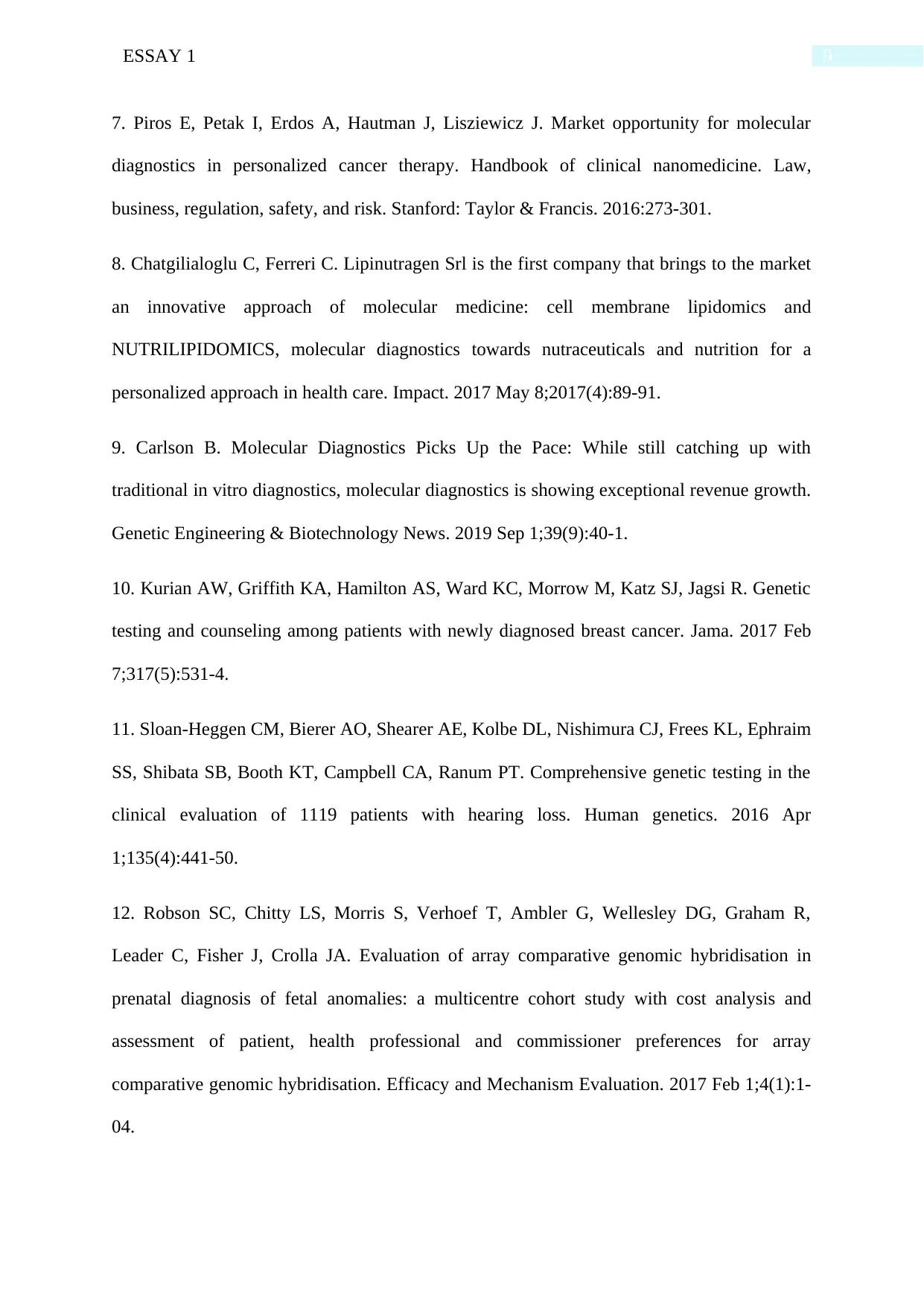
9ESSAY 1
7. Piros E, Petak I, Erdos A, Hautman J, Lisziewicz J. Market opportunity for molecular
diagnostics in personalized cancer therapy. Handbook of clinical nanomedicine. Law,
business, regulation, safety, and risk. Stanford: Taylor & Francis. 2016:273-301.
8. Chatgilialoglu C, Ferreri C. Lipinutragen Srl is the first company that brings to the market
an innovative approach of molecular medicine: cell membrane lipidomics and
NUTRILIPIDOMICS, molecular diagnostics towards nutraceuticals and nutrition for a
personalized approach in health care. Impact. 2017 May 8;2017(4):89-91.
9. Carlson B. Molecular Diagnostics Picks Up the Pace: While still catching up with
traditional in vitro diagnostics, molecular diagnostics is showing exceptional revenue growth.
Genetic Engineering & Biotechnology News. 2019 Sep 1;39(9):40-1.
10. Kurian AW, Griffith KA, Hamilton AS, Ward KC, Morrow M, Katz SJ, Jagsi R. Genetic
testing and counseling among patients with newly diagnosed breast cancer. Jama. 2017 Feb
7;317(5):531-4.
11. Sloan-Heggen CM, Bierer AO, Shearer AE, Kolbe DL, Nishimura CJ, Frees KL, Ephraim
SS, Shibata SB, Booth KT, Campbell CA, Ranum PT. Comprehensive genetic testing in the
clinical evaluation of 1119 patients with hearing loss. Human genetics. 2016 Apr
1;135(4):441-50.
12. Robson SC, Chitty LS, Morris S, Verhoef T, Ambler G, Wellesley DG, Graham R,
Leader C, Fisher J, Crolla JA. Evaluation of array comparative genomic hybridisation in
prenatal diagnosis of fetal anomalies: a multicentre cohort study with cost analysis and
assessment of patient, health professional and commissioner preferences for array
comparative genomic hybridisation. Efficacy and Mechanism Evaluation. 2017 Feb 1;4(1):1-
04.
7. Piros E, Petak I, Erdos A, Hautman J, Lisziewicz J. Market opportunity for molecular
diagnostics in personalized cancer therapy. Handbook of clinical nanomedicine. Law,
business, regulation, safety, and risk. Stanford: Taylor & Francis. 2016:273-301.
8. Chatgilialoglu C, Ferreri C. Lipinutragen Srl is the first company that brings to the market
an innovative approach of molecular medicine: cell membrane lipidomics and
NUTRILIPIDOMICS, molecular diagnostics towards nutraceuticals and nutrition for a
personalized approach in health care. Impact. 2017 May 8;2017(4):89-91.
9. Carlson B. Molecular Diagnostics Picks Up the Pace: While still catching up with
traditional in vitro diagnostics, molecular diagnostics is showing exceptional revenue growth.
Genetic Engineering & Biotechnology News. 2019 Sep 1;39(9):40-1.
10. Kurian AW, Griffith KA, Hamilton AS, Ward KC, Morrow M, Katz SJ, Jagsi R. Genetic
testing and counseling among patients with newly diagnosed breast cancer. Jama. 2017 Feb
7;317(5):531-4.
11. Sloan-Heggen CM, Bierer AO, Shearer AE, Kolbe DL, Nishimura CJ, Frees KL, Ephraim
SS, Shibata SB, Booth KT, Campbell CA, Ranum PT. Comprehensive genetic testing in the
clinical evaluation of 1119 patients with hearing loss. Human genetics. 2016 Apr
1;135(4):441-50.
12. Robson SC, Chitty LS, Morris S, Verhoef T, Ambler G, Wellesley DG, Graham R,
Leader C, Fisher J, Crolla JA. Evaluation of array comparative genomic hybridisation in
prenatal diagnosis of fetal anomalies: a multicentre cohort study with cost analysis and
assessment of patient, health professional and commissioner preferences for array
comparative genomic hybridisation. Efficacy and Mechanism Evaluation. 2017 Feb 1;4(1):1-
04.
Paraphrase This Document
Need a fresh take? Get an instant paraphrase of this document with our AI Paraphraser
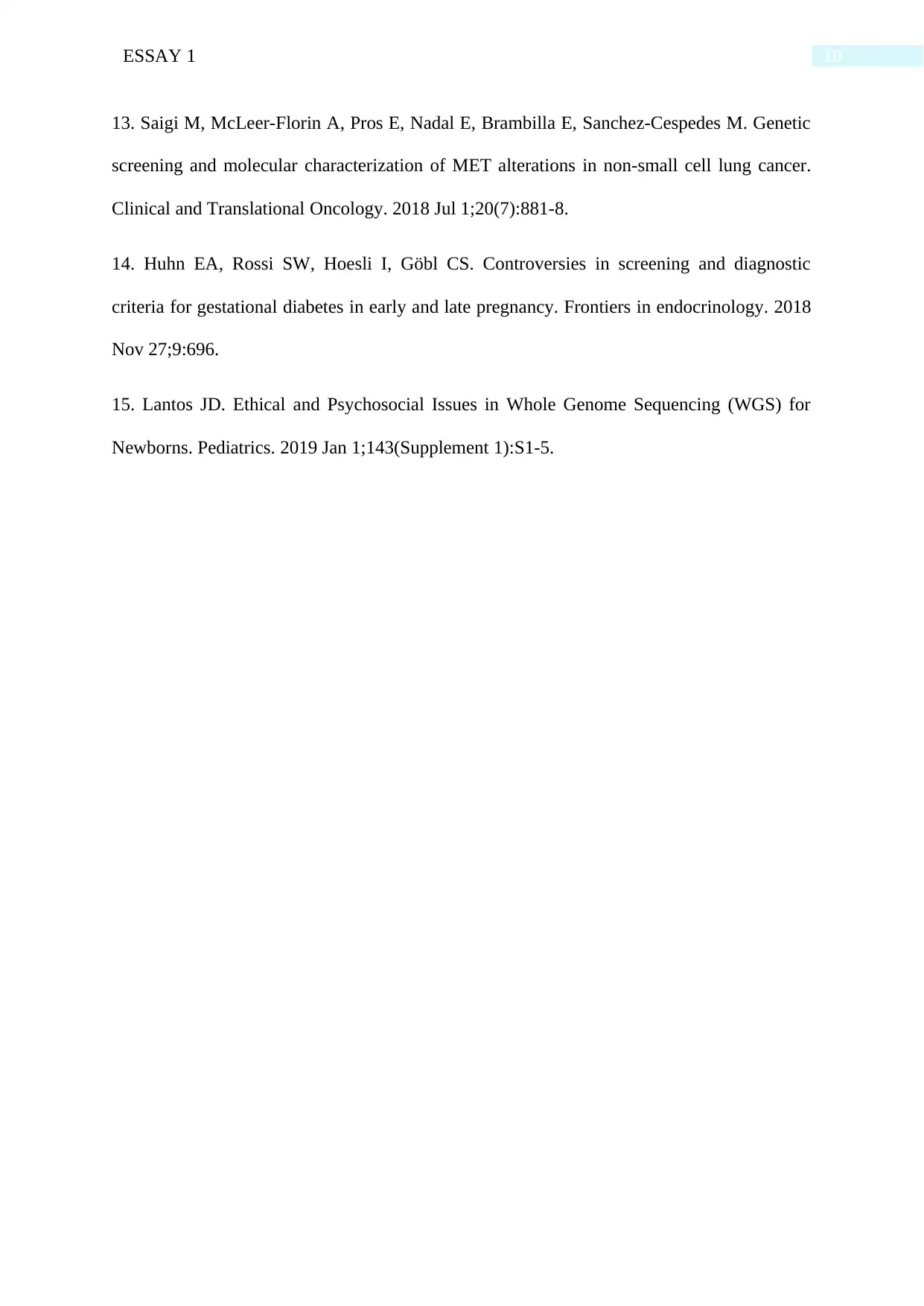
10ESSAY 1
13. Saigi M, McLeer-Florin A, Pros E, Nadal E, Brambilla E, Sanchez-Cespedes M. Genetic
screening and molecular characterization of MET alterations in non-small cell lung cancer.
Clinical and Translational Oncology. 2018 Jul 1;20(7):881-8.
14. Huhn EA, Rossi SW, Hoesli I, Göbl CS. Controversies in screening and diagnostic
criteria for gestational diabetes in early and late pregnancy. Frontiers in endocrinology. 2018
Nov 27;9:696.
15. Lantos JD. Ethical and Psychosocial Issues in Whole Genome Sequencing (WGS) for
Newborns. Pediatrics. 2019 Jan 1;143(Supplement 1):S1-5.
13. Saigi M, McLeer-Florin A, Pros E, Nadal E, Brambilla E, Sanchez-Cespedes M. Genetic
screening and molecular characterization of MET alterations in non-small cell lung cancer.
Clinical and Translational Oncology. 2018 Jul 1;20(7):881-8.
14. Huhn EA, Rossi SW, Hoesli I, Göbl CS. Controversies in screening and diagnostic
criteria for gestational diabetes in early and late pregnancy. Frontiers in endocrinology. 2018
Nov 27;9:696.
15. Lantos JD. Ethical and Psychosocial Issues in Whole Genome Sequencing (WGS) for
Newborns. Pediatrics. 2019 Jan 1;143(Supplement 1):S1-5.
1 out of 11
Related Documents
Your All-in-One AI-Powered Toolkit for Academic Success.
+13062052269
info@desklib.com
Available 24*7 on WhatsApp / Email
![[object Object]](/_next/static/media/star-bottom.7253800d.svg)
Unlock your academic potential
Copyright © 2020–2025 A2Z Services. All Rights Reserved. Developed and managed by ZUCOL.





